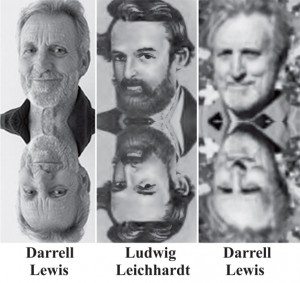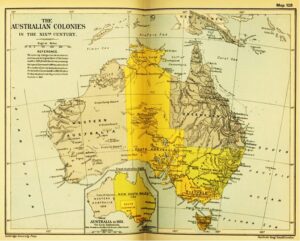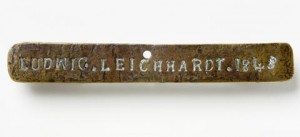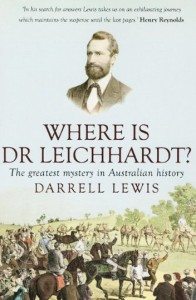Reincarnation Case of Ludwig Leichhardt | Darrell Lewis: Australian Explorers Across Two Lifetimes
- CATEGORY
Proposed by: Terry Olesen, PhD, of Perth, West Australia
Affirmed by: Spirit Guide or Spirit Being Ahtun Re in a Ryerson-Semkiw Reincarnation Research Session
Article by: Terry Olesen, PhD
Ludwig Leichhardt and his Exploration of Australia
 The exploration of Australia has a long and noble history of explorers scouting its vast reaches. I read the intriguing story of one such nineteenth century “Age of Discovery” explorer, Dr. Ludwig Leichhardt, covered in the August 17 2013 edition of Australian Weekend Magazine. This article suggests not one man’s life story of exploration–but two, seemingly in parallel.
The exploration of Australia has a long and noble history of explorers scouting its vast reaches. I read the intriguing story of one such nineteenth century “Age of Discovery” explorer, Dr. Ludwig Leichhardt, covered in the August 17 2013 edition of Australian Weekend Magazine. This article suggests not one man’s life story of exploration–but two, seemingly in parallel.
There was Leichhardt’s (b. 1813 – d.1848?) exploration of “Down Under” in the middle of the 1800s. Then there was the equally captivating modern journeys of his biographer 160 years later, cultural historian and de facto folk archaeologist, Dr. Darrell Lewis (b. 1949).
Whilst the content of the two men’s stories were striking in and of itself, even more striking was the scientific curiosity, love of the natural world, travel lust and drive that both men demonstrated. A comparison of the facial architecture between Dr. Leichhardt (via sketches and daguerreotypes) and Dr. Lewis (photographs, video recordings) are amazingly similar.
I believe this to be, as Ian Stevenson, MD would say, “A Case Suggestive of Reincarnation.”
Reincarnation Indicators in the Proposed Case of Ludwig Leichhardt | Darrell Lewis
In reviewing this case I wanted to rely on the protocols established/codified by Walter Semkiw, MD. Walter Semkiw has listed these indicators as Principles of Reincarnation. I describe now this case in detail and how the indicators “‘match up” in the lives of both men. At the end of this article I provide a summary of the indicators and make some conclusions. I also enclose an early map of Australia, and the sources from which I draw this case study.
The Journey of Ludwig Leichhardt: Explorer, Naturalist & Researcher of the Australia Outback
 The Australian Weekend Magazine began by quoting the modern day personality Darrell Lewis:
The Australian Weekend Magazine began by quoting the modern day personality Darrell Lewis:
“In 1848 an expedition led by German-born scientist Ludwig Leichhardt set out from Moreton Bay (Brisbane) with the intention of crossing the continent to the Swan River (Perth). The mission?: A 500 km east-to-west scientific expedition on horseback covering the virtually unknown Australian center. The trip was expected to take two to three years, but instead the entire expedition disappeared and its fate remains a mystery to this day.”
It is now recognised that in his time Leichhardt was the best-trained scientist-explorer that blessed Australia, having studied under many of the most eminent European scientists and being schooled during the Age of Discovery. He was a mere lad of 20-something when he arrived. Leichardt was the Indiana Jones of white Australia’s settlement.
Yet his demise and story became an enduring mystery that has segued into legend. It is speculated that the party met a grisly or dire end (starvation, disease, being waylaid). However their remains and expedition gear were never found. This is somewhat surprising given that the Leichhardt Expedition consisted of seven well-prepared men, eight horses, 20 mules, five camels and enough gear/supplies to last the three years of effort.
Over the last 150 years the Leichhardt exploration mystery has nibbled at the Australian collective unconscious. Three government and close to a half-dozen private expeditions have since tried to retrace and uncover Leichhardt & Company’s final fate. None of these forays were successful in determining how Leichhardt’s Party ended their journey, what they learned or discovered (Leichardt’s habit was to keep meticulous records of his scientific, geographic and cultural findings in leather-bound notebooks).
Ludwig Leichhardt’s Brass Gun Plate is Found
 Some 150 years after his death, in the late 1990s a South Australian museum chanced upon a final vestige of that Expedition: a brass gun plate clearly bearing Leichhardt’s name and the date 1848. Curators, physical scientists and archaeologists are agreed the find is authentic.
Some 150 years after his death, in the late 1990s a South Australian museum chanced upon a final vestige of that Expedition: a brass gun plate clearly bearing Leichhardt’s name and the date 1848. Curators, physical scientists and archaeologists are agreed the find is authentic.
Aboriginal groups claim it was found in Western Australia in the Tanami Desert/Sturt River area, a location far from where most commentators thought Leichardt would have ended up. This is accepted by the modern-day personality/biographer Lewis; however, the many other team artifacts were never located.
The original Aboriginal man who found the object was a stockman who is unlikely to be a forger or a liar. Experts indicate the plate was said to be taken from a tree from which hung a burnt rifle stock and a leather sling. The tree in question, a Boab tree (aka Bottle Tree), was thought to be non-native to the region but later research showed these trees are still extant in the Tanami Desert. Lewis among others has searched this area for such a tree, as Leichhardt often left his landmarks on such trees with an emblazoned “L.”
Where have the artifacts from such a large party gone? The Australian Weekend Magazine writer Nicholas Rothwell ends his piece “and perhaps that last tree is still there, somewhere, still awaiting its discoverer, lost in the desert’s hazy, mirage-like light, an ancient, weathered witness, with a spectral “L” mark blazed upon its trunk.”
The Journey of Darrell Lewis: Australian Academic, Field Hand & Historian, 1947-present
 Nicholas Rothwell covers the biography of Darrell Lewis at length in the August 2013 issue of Weekend Australian Magazine. I will only summarise it here.
Nicholas Rothwell covers the biography of Darrell Lewis at length in the August 2013 issue of Weekend Australian Magazine. I will only summarise it here.
Born in 1949 in Wagga Wagga, New South Wales, Darrell Lewis was introduced to Australian outback history, as well as gun-smithing, early on. In his teens, he became an apprentice plumber. This he hated. Fortunately at the end of his fifth year of plumbing “a boon” fell into his lap; he was hired to be a geologist/surveyor for the Bureau of Mineral Resources in the vast area known as the Victoria River District, or VRD. There he was introduced to hydrographical exploration and natural history fieldwork. He wrote: “…I was high; I was going to the Outback: it was a wonderful adventure. I was looking intently. I saw it all: new animals, the change in vegetation, and the rocks.”
The following year Lewis was transferred to the very most northern end of Australia, Arnhem Land. Rothwell said of this turning point: “He saw the region’s rich rock art, and was overwhelmed. He was meeting great Scholars and Scientists, and spending his days with wild bush characters…traditional Aboriginal people living on their own country. The past he had lamented down in the Riverina (Victoria) wasn’t ‘past’ at all up north.” The Northern Territory Museum hired Lewis as site recorder for state museum; the natural and cultural history of the “Top End” became his special focus, just as it had been for Leichardt 140 years earlier.
Déjà Vu: Darrell Lewis Becomes the Expert that Ludwig Leichhardt Strove to Be
 Here is where the stories of the two men overlap to an uncanny extent. As part of his job as a museum researcher, Lewis, according to Rothwell, “headed far into that [Northern Territory] landscape. He rediscovered the old forgotten station tracks and homestead ruins…he became a detective of its past. He tracked down northern Cattlemen from early days and picked their memories. He minded the archives. Slowly, surely he was reinventing himself—from an amateur he became an expert.” [Italics added]
Here is where the stories of the two men overlap to an uncanny extent. As part of his job as a museum researcher, Lewis, according to Rothwell, “headed far into that [Northern Territory] landscape. He rediscovered the old forgotten station tracks and homestead ruins…he became a detective of its past. He tracked down northern Cattlemen from early days and picked their memories. He minded the archives. Slowly, surely he was reinventing himself—from an amateur he became an expert.” [Italics added]
Now in his late 20s Lewis found himself needing credentials to be more widely heard. He enrolled at a leading scientific institution, the Australian National University (ANU). Lewis finished with distinction honours and then married American Anthropologist Deborah Bird Rose.
Ludwig Leichhardt & Darrell Lewis: Meticulous Researchers
They migrated north to Queensland to study Aboriginal cultures firsthand. While in the “top end” he continued his burning desire to research native culture and their artifacts. Rothwell notes that Lewis had such a tendency toward thoroughness, that he (Lewis) complied a “kind of Domesday Book for the Victoria River Districts containing every surviving scrap of information about the old runs and homesteads, their managers and their vivid history, containing not just official records but the recollections of ‘remarkable but little known bushmen’ along with an archive of 6,000 period photos.”
Rothwell then quotes Lewis on this tendency: “I like to capture memories that would otherwise be lost….to pin down stories with hard proof, find their material traces in the landscape. Tie up the loose ends, finish off the stories we find out in the country, just lying there.” [Italics added].
Darrell Lewis on the Trail of Ludwig Leichhardt
Sometime in 2003 Lewis stumbled upon a letter of 1890 written by botanist Ferdinand von Mueller, a letter which suggested Leichhardt’s final resting place to be near Lake Mackay in the deserts of Western Australia (See Map). Again almost compulsively Lewis undertook a ravenous and widespread investigation of archives and accounts related to Leichardt’s itinerary and intentions.
From this Lewis constructed a non-traditional but quite feasible alternative theory. Lewis’s belief was that Leichhardt and Company had successfully journeyed across the top end of Australia skirting the top end river catchments and moving through savannah. Lewis concluded and now argues that the Party met their end somewhere in the Tanami Desert, at the southern tip of the somewhat diminished Sturt River. About two years following Lewis’s new narrative based on the von Mueller letter, the South Australia Museum obtained the brass gun plate bearing Leichhardt’s name.
Spirit Being or Spirit Guide Intervention in Reincarnation Cases
From a spiritual point of view, one may speculate that such pieces of “evidence,” such as the brass gun plate with Leichhardt’s name on it, were discovered through the intervention of “invisible hands” or synchronicities orchestrated by the spiritual worlds, a phenomenon observed in, as Dr. Semkiw calls them, “affinity cases,” where a person is unconsciously attracted to their own past life persona. To learn more, go to: Spirit Beings in Reincarnation Cases
Ludwig Leichhardt | Darrell Lewis as a Proposed Affinity Reincarnation Case & Where is Ludwig Leichhardt? by Darrell Lewis
 2003 Darryl Lewis graduated with a PhD in Cultural History from the ANU. His thesis has become the basis for his book, Where is Ludwig Leichardt?
2003 Darryl Lewis graduated with a PhD in Cultural History from the ANU. His thesis has become the basis for his book, Where is Ludwig Leichardt?
While Lewis himself admits the brass gun plate doesn’t establish the Leichardt Expedition’s final resting place, it does offer a view of the journey that Leichardt had indeed made an East-West Passage a reality. (Something that many at the time hoped Leichardt could and would do; but later many doubted. Could the “soul” of Leichardt be seeking to set the record straight?)
Darryl Lewis in his book argues strongly that Leichhardt had indeed reached the furthest West frontier of the huge island continent (it was in UK courts referred to as Terra Nullius (“Great Empty Land”). Due to a combination of physical accident, robbery and perhaps heat exhaustion the team failed to complete the final 2550 kilometres to the Swan River Colony, just north of Perth. Yet since the publication of Lewis’s book and Rothwell’s article, the Leichhardt Legend has gone viral in the Australian mind– at least among historians, writers, bush legend readers, and adventurers.
Finally at the end of his article Rothwell quotes Lewis as citing again the Aboriginal oral history; this basically recites (I don’t yet have the exact text) that a band of “perished horsemen” could not negotiate the remote desert landscape near Lake Mackay after travelling down from Sturt Creek. (Note to Reader: Native Aboriginals did NOT have means to travel by horses in 1848; horses were both a rarity and non-native to Australia).
Match Ups or Correlates between Ludwig Leichhardt & Darrell Lewis
In keeping with the Semkiw Reincarnation Principles (Indicators) I outline below points where I found matches between the two personalities/lifetimes on several indicators. It is obvious that the matches are many.
Facial architecture is the same (physical resemblance)
Both were driven to become experts in their fields
Both had a tendency to read and analyze archives
Both immersed themselves in the natural sciences including geology and hydrology, with an emphasis on the study of rivers
Both explored uncharted lands with a love for the wilderness
Both organized extensive expeditions with skill and with the use of pack animals
Both were “hands on” people and both were skillful with firearms
Both used anthropological methods with careful recording using journals
Both were published by scientific societies
Both men “discovered” their calling toward natural science via “hands on” exploration in their early 20s,
Both left the comfort of Anglo-European culture,
Both had/have similar fascinations with natural history of Australia,
Both associated with experts in cultural anthropology and universities,
Both demonstrate ability to live in wild reaches (again almost entirely in Australia, not elsewhere).
Summary/Final Note
I have more work to do in this investigation. For now, we can see the many overlapping facets in both men’s life pathways. In addition, this case features what Dr. Semkiw calls an “anniverary phenomenon,” in that Darrell Lewis was born 100 years after Leichardt’s death. Leichardt died in 1848 or 1849, while Lewis was born in 1949.
I note with particular interest the fact that gun paraphernalia was an early interest of D. Lewis. It was a piece of paraphernalia, namely the gun brass name plate with Leichardt’s name on it, that is a most important piece of evidence in retracing the path of Leichhardt’s final expedition. I also note that Lewis’s grand life project is to shed light on Leichardt’s journey. As noted, his book is entitled, Where is Dr. Leichhardt.
It’s as if Lewis/Leichardt is trying to come to terms with his own earlier (undesired?) death. I note that Leichardt would have disliked the idea of his findings being waylaid, abandoned or destroyed. This would have concerned Leichardt greatly.
I feel as a reincarnation researcher that it would be of great benefit if Dr. Lewis agreed to be interviewed to shed light on how he became so motivated to explore a dead explorer’s life for half of his own life. As noted before, if this case is valid, it demonstrates another of Dr. Semkiw’s principles, in which an individual is unconsciously attracted to their own past incarnation. Semkiw terms these types of cases “affinity cases.” Two other affinity cases include those of Halle Berry and Laurel and Hardy. Links to these cases are provided below:
Dorothy Dandridge | Halle Berry
Laurel and Hardy | Josh and Danny Bacher
Note by Walter Semkiw, MD: Darrell Lewis Affirmed as the Reincarnation of Ludwig Leichhardt
 In a session with Kevin Ryerson, Ahtun Re, a spirit guide or spirit being channeled through Kevin who has demonstrated an ability to make past life identifications with a high degree of accuracy, agreed that Darrell Lewis is the reincarnation of Ludwig Leichhart. To learn more about my work with Kevin and Ahtun Re, go to: Ryerson-Semkiw Reincarnation Research
In a session with Kevin Ryerson, Ahtun Re, a spirit guide or spirit being channeled through Kevin who has demonstrated an ability to make past life identifications with a high degree of accuracy, agreed that Darrell Lewis is the reincarnation of Ludwig Leichhart. To learn more about my work with Kevin and Ahtun Re, go to: Ryerson-Semkiw Reincarnation Research
Principles of Reincarnation & Understanding Past Lives
Physical Resemblance in Reincarnation Cases: There is a similarity in bone structure, or facial architecture, shared by Darrell Lewis and Ludwig Leichhardt. Younger images of Darrell Lewis would likely show a more impressive physical resemblance.
In addition, Leichhardt and Lewis have worn very similar beards. Reincarnation research shows that men, from one lifetime to another, often maintain the same facial hair. Examples include:
Explorer Reincarnation Case of Sir George Wilkins | Astronaut Edgar Mitchell
Reincarnation Case of General John B. Gordon | Jeff Keene
Police Captain Robert Snow as the Reincarnation of Carroll Beckwith
Past Life Talent: As described above, Darrell Lewis shares many skills, abilities and interests with Ludwig Leichhardt.
Change in Nationality and Ethnic Affiliation: Leichhardt was German, while Lewis was born in Australia.
Sources
Aboriginal History – Volume 37. Chapter: “Where is Dr Leichhardt? The Greatest Mystery in Australian History.” Edited by Shino Kohiro. Australian National University, 2013.
Lagan, Bernard. What really happened to Ludwig Leichhardt? He went missing in the Australian desert and inspired Patrick White’s greatest novel. Where did he go? The Global Mail(theguardian.com), Friday 31 May 2013.
Lewis, Darrell. The Fate of Leichhardt, Historical Records of Australian Science 17(1) 1 – 30
2 June 2006
Rothwell, Nicholas. “L” Marks the Spot. The Weekend Australian Magazine. 17-18 August 2013.